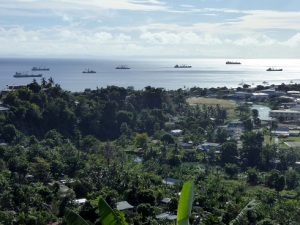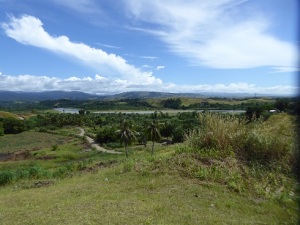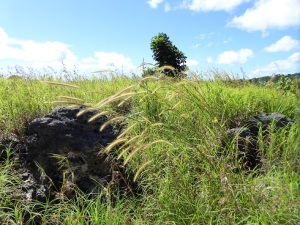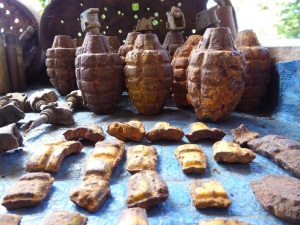It’s cuppa tea time, people, because here comes another lengthy blog for your enjoyment. I also apologise in advance for any errors written – I’m sure there are plenty.
********
Solomon Islands is really only known for two things: Great diving, and the WWII Battle of Guadalcanal. Since coming here, I have done my best to experience the country’s amazing underwater life. I felt it was about time to learn more about its second claim to fame.
Every year, historian and WWII enthusiast, John Innes, makes his way to Honiara to conduct tours to some of the key spots in the island’s battles. I decided to join. The one-day tour took us from the:
- US Memorial (Opened on 7th August 1992 to celebrate the 50th anniversary of the American landing in Guadalcanal)
- Kola Ridge (the site of action where Mitchell Paige won the Medal of Honour….and now someone’s house),
- Japanese Memorial (a shrine built in the 80’s where, every year, a memorial is held).
- Track of the 2nd Raider Battalion on Mt Austen
- Japanese spy observation point over Honiara shrouded by long grass
- Mt Austen and the site of the Gifu,
- Alligator creek, and
- Bloody Ridge.
This is what I learnt:
Going back
In 1893, the British took over the protectorate of the Solomon Islands, and set up the capital at Tulagi in Central Islands Province. The biggest industry at the time was copra, and it remained a sleepy backwater of the British Empire. Tulagi is an excellent anchorage – steep into the water – and in 1924, the Royal Navy recommended the British transfer the Far East fleet from Singapore to Tulagi. Due to the cost, they did not. How different Solomon Islands would be now if that recommendation had been accepted!
By the time the second world war arrived, there were only about 500 expatriates spread throughout the Solomon Islands.
The Japanese entered the war in 1941, in a bid to take over the European empires, force America to the negotiation table, and have them recognise Japan as a leading player. On the 3rd May, 1942, the Japanese headed for Tulagi.
At the time, Tulagi was defended by 18 Australians. When they heard news of the pending invasion, they took off. Three hours after their departure, the Japanese took over and set up a sea plane base, as well as having long-range flying boats.
The first American involvement was on the 4th May, 1942. They had heard about the Japanese landing in Tulagi so, on their way to the Battle of the Coral Sea, they sent two aircraft carriers over Tulagi to bombard the Japanese ships. All this managed to achieve was to let the Japanese know that Americans had aircraft carriers in the area.
The 1st Marine Division
Meanwhile, the Japanese settled into Tulagi and quickly identified a flat bit of ground in Guadalcanal perfect for an airstrip. They sent over 3000 construction workers, guarded by 247 Special Forces, to construct an airstrip at Henderson Field.
Eight Australian volunteer coast watchers (the ones that didn’t flee) – each supported by around 100 Solomon Islanders – remained behind enemy lines and fed information on the airstrip construction to the Americans. Bolstered by a recent victory in the Pacific, the Americans decided to attack. Unfortunately, the only people available were the 1st Marine Division.
Now, a Division is made up of several regiments, with 3 battalions per regiment, and 1000 men per battalion. Within the 1st Marine Division were two Raider Battalions of 900 men each. A raider is the equivalent of a British commando.
The 1st Raider Battalion was led by Colonel Edson (of Bloody Ridge fame). The 2nd Raider Battalion was led by Evans Carlson, who had previously had experience fighting against the Japanese alongside Communist China. When Carlson had carefully selected his Battalion (choosing only 1 in 3 marines), he used revolutionary tactics learnt in China. One of the most famous tactic was a catchcry used to motivate his men, meaning “Working together”. The term in Chinese is “Gung ho”.
The 1st Marine Division had arrived in New Zealand in June, 1942, and had never experienced a battle together. Led by General Vandegrift, they had expected to be given 6 months of training but, instead, were handed a note giving them 6 weeks to prepare for Guadalcanal. After much protest, the seniors relented and gave them an extra 6 days. Fortunately, the climate of New Zealand is just like that of the Pacific, so the training they did have was totally appropriate.
Landing at Red Beach – 7th August, 1942
On the 1st August, the 1st Marine Division set out towards Guadalcanal. The Japanese were oblivious to this development and continued operations as usual. From this point on, luck landed on the side of the Americans and played a big part in their success in Guadalcanal.
On the 5th & 6th August, the weather was terrible, so the usual reconnaissance flights made by the Japanese were abandoned, allowing the US ships to enter undetected. In fact, due to construction of the airfield moving ahead of schedule, the Japanese also held a party on the 6th August, leaving them hungover for the American’s arrival on the 7th.
The Americans came from the Western end of Guadalcanal, past Savo Island. Some Battalions landed at Blue Beach in Tulagi, Florida Islands, and the small islands of Gavutu-Tanambogo (all in current-day Central Province). They faced strong resistance from the Japanese and suffered many casualties. With support from the Division Reserve, all three islands were cleared of Japanese within a couple of days.
The remaining Battalions sailed on to Guadalcanal where they expected 7,000 Japanese to be stationed. The admiral in charge decided to land Red Beach*, where the swathes of Guadalcanal Province Palm Oil Limited (GPPOL) palm plantations are now situated.
This was a rather stupid move, as the beach is in the middle of a bay. Had Japanese soldiers been situated anywhere on that bay, the Americans would have had to endure inflow fire from both sides. As mentioned though, the Japanese were caught unaware, allowing the Americans to sail in without resistance. Their arrival was extraordinarily anti-climactic.
* A common misconception is that Red Beach is named for the blood shed there, however no fighting occurred at Red Beach. There are three designated beaches: Red Beach in Honiara, Blue beach in Tulagi, and White Beach at the islands of Gavutu-Tanambogo.
Takeover of Henderson Airfield – 8th August, 1942
Seeing no Japanese upon landing, the Americans automatically assumed that they were planning a sneaky attack, so the marines took a very cautious 36 hours to reach the airfield at Henderson.
Meanwhile, instead of staying to defend the airfield, the Japanese Engineer in Charge thought it would be a good idea for everyone to leave, go to the other side of the Mataniko River, and wait for the Americans to move on before going back and finishing off the airstrip. They left everything – trucks, fuel, generators, radios – ensuring that construction of the airport could resume quickly upon their return.
Of course, the Americans didn’t leave. They took over Henderson airfield on 8th August, and all its construction machinery, without any struggle. They immediately set up a defensive posture facing the sea, with a two-mile front, and shoulders 500 yards back.
When they did this, though, what they found was an empty sea. On the night of the 7th August, the Japanese had sent seven cruisers and one destroyer to do a U-turn around Savo Island. In the 38 minutes it took to do that, they destroyed five American ships. The Captain of the remaining US ships decided to head off to avoid further attack, leaving the Marines marooned on Guadalcanal.
With few options, no supplies or artillery, and 2000 men short, the Americans proceeded to complete construction of the airport using the Japanese equipment, and surviving on Japanese food supplies. The first plane – a Catalina – landed on 12th August, 1942.
Battle of Tenaru (Alligator Creek / Ilu River) – 20th August, 1942
After the takeover of Henderson, the Japanese realised that they needed more people to defeat the Americans. Their intelligence told them that there were 2,000-3,000 Americans, so they responded by sending 911 men. In reality, there were more like 11,000 marines.
Led by Colonel Ichiki, the Japanese landed at Taivu point on 18th August, and made their way towards the airfield. At this point, the Americans were unaware that the Japanese had landed, however the 1st marine regiment had already set up a perimeter at Alligator Creek (1st battalion in reserve, 2nd battalion along the river, and the 3rd battalion along the sea).
On 20th August, the Japanese came close to Alligator Creek and met a local man called Jacob Vouza who was carrying an American flag. Vouza was a retired policeman who served as a Coast watcher and Headman for the British District Officer, Martin Clemens.
As the Japanese questioned and tortured Vouza to get information on the Americans. Seeing the small number of Japanese men, Vouza decided to lead them to Alligator Creek where he knew that thousands of Americans were waiting.
That night, Ichiki told his men that they were going to attack. The tactic of the Japanese is to attack at night, while the Americans attack during the day. This forced the Americans to stay put all night, urinating into their helmets rather than going to the bush, for fear of being mistaken as the enemy.
Ichiki first ordered a company of men to walk across the Alligator Creek at 0310 hours. They were quickly decimated by the waiting Americans. Ichiki sent another company of men, and then another. Very quickly, 300 Japanese soldiers were dead. Then it settled down into a two-sided shelling.
With information from Vouza, the Vandegrift released the 1st battalion from reserve, who crossed the river upstream and launched an enveloping attack, which led to complete annihilation of the Japanese. Of the more than 800 Japanese soldiers, only 26 survived. Of the 11,000 marines, 35 died and 75 were injured.
The Americans scraped out a grave to bury all the Japanese bodies. A run-down headstone sandwiched between leaf huts now marks the spot. For his efforts, in this battle and others, Vouza has been immortalised in a statue out the front of Rove police station.
The battle at Alligator creek is also famous for one other incident involving three marines – Leroy Diamond, Johnny Rivers, and Al Schmid. On the 20th August, the three men opened fire with a machine gun. The Japanese were able to pick out where the shots were coming from, so they fired back and hit Johnny Rivers and killed him. Diamond and Schmidt took over but, a little later, a mortar round came through and blew the hands off Diamond and blinded Schmidt. Between them they still had a good pair of hands and a good pair of eyes, and they kept firing the gun all night. They were awarded the Navy Cross for their efforts.
Battle of Bloody Ridge – 12th September, 1942
The Americans started numbering the hills, with the site of bloody ridge originally being named Hill 1 & 2.
By late August, the 1st Raider Battalion and 1st Parachute Battalion were moved from Tulagi to strengthen the defence of the Guadalcanal beachhead. First they went to Savo, then were put on an expedition to go to Tasamboko in the East. They got to General Kawaguchi’s headquarters after he had already left. So, the Americans took everything of value and burned the rest.
The Americans then tried to identify the line of approach for the Japanese return. General Vandegrift insisted that the Japanese would return along the ocean front, which would have been reasonable if the Japanese were coming by boat. However, since the Japanese were already on land, the operations officer, General Thomas, and head of the 2nd Raiders division, Colonel Edson, felt they would approach from the ridge south of the Airfield – Hill 123. Thomas and Edson were ignored.
At the same time, the 1st Marine Division headquarters was located next to the Lunga river and close to Henderson airstrip (where Willie’s Electrical now stands), meaning that they were subject to all the overnight shelling and daily bombing, and giving it the name ‘Impact Centre’. Vandegrift decided to move the headquarters to a quieter spot, and he chose Hill 123. This concerned General Thomas and Colonel Edson greatly. So, they went to the General and asked that their men be allowed to rest and recuperate at Hill 123. General Vandegrift agreed, and the Raiders and Parachute Battalion moved in there on 11th September.
By now, Colonel Edson had 760 men (three companies) under his command. He stationed the B company of Parachute Battalion on top of the hill, the B company of the Raiders from the top of the hill going down to the base, and the C company of the Raiders from the base of the hill to the edge of the Mataniko river. That was the front line, and it was very, very thin.
Meanwhile, General Kawaguchi had returned with his 5,280 men. They landed to the East, and then cut inland to attack the Americans from the undefended rear (remember, the Americans had set up a defence posture facing the sea). They attacked on the 12th September, however got lost in the jungle in the process. Instead of having 3,000 men reach the Americans at the same time (who easily would have defeated the thin front line), they only attacked with about 250 men.
The attack occurred in the dense jungle next to Mataniko river, where the C company of Raiders were stationed. The C company was easily overrun – they had no time to build fields of fire, clear the grass, or set up barbed wire. This was a minor success for the Japanese, but it also served to notify the Americans of which direction the Japanese were attacking from.
So on the next day – the artillery of the 11th Marines were allocated to defend the ridge. They had all day to register the guns on their targets. The Japanese attacked again that night, but the Americans were ready for them. In the end, the mass amounts of artillery won that battle for the US.
A memorial in honour of this battle is located at the Central Police Station (opposite the Mendana).
The Battle of Coffin Corner – 24th October 1942
After the defeat at Bloody Ridge, the Japanese then allocated 8,500 men to make another attack in October. They landed to the West at Poha River, and then cut a difficult trail inland, taking 5 days to reach their destination.
On the 23rd October, the Japanese made an attack across the Mataniko River (In fact, the turret of one of the tanks can still be seen in the river, about 50m in from the shore, on the side of the hospital). This attack spooked the Americans into thinking that the main attack from the Japanese would come from the mouth of the Mataniko. So, the US put one battalion in to protect an attack from that direction, with 46 men on lookout. They had a very thinly held line, but it was bristling with fire power.
On the 24th, the Japanese started to move into position, streaming past the outpost where Sergeant Briggs was located. Briggs got on the phone to the command post, who asked him how many Japanese he thought there were. He replied “The whole f….ing army”. Chesty Puller got word to his men to hold fire until the last possible moment, allowing Briggs and the men stationed at the outpost to quickly move out.
Instead of attacking as one mass force of 8,000 men, the Japanese started to string out. They fed themselves in, one company at a time. In doing so, they were being chewed up by the firepower of the Americans. Still, the marine line was buckling and, for the first time, they allowed another battalion of army to be filtered into the American line to boost numbers. Later, Chesty Puller commented that “the army fought like marines”. I assume that’s a compliment.
In the end, there were so many dead Japanese that one of the marines said “If you were a coffin maker, you’d make a fortune”. Hence, the second battle at Lunga Ridge is named the Battle of Coffin Corner.
The Gifu (Hill 27 / Mt Austen) – January 1943
In October 1942, the Japanese set up a very strong and static defensive position of about 800 men at Mt Austen (Hill 27), with supporting foxholes and big bunkers five logs deep. The marines knew they were there, but sealed them off and ignored them.
By December 1942, the 1st Marine division had been relieved, and replaced by another marine division with two army divisions. One of the army regiments was insistent on taking back Hill 27.
On the 17th December, the 1st and 3rd battalions of the 132nd infantry commenced their attack on the Japanese positions. Unaware of how strong the Japanese defensive positions were, they failed to make a dent.
On the 19th, the Colonel of the 3rd battalion – Colonel Wright – went forward and was throwing hand grenades at Japanese machine gun. He succeeded. The Americans continued on the offensive but, despite being bombed and shelled, the Japanese were very secure in their positions.
On 1st January, the US released the 2nd battalion from reserve. They made their way around the flanks of the battle, attacked the Japanese from behind, and took Hill 27. The Japanese had five attempts to retake the hill, to no avail. As dusk approached, the Americans went to a more easily defended night position and allowed the Japanese to come on to the hill. As they did that, they called in the artillery who was at the mouth of the Mataniko and blasted the Japanese out with high explosives. It was impossible to survive.
The Americans then set up a perimeter around the area. Despite being surrounded, the Japanese still refused to give in. On the 22nd January, the army brought in three tanks. Two of these were immediately bombed, but the remaining tank managed to pierce the Japanese line and come back out. That night, the 89 remaining Japanese were ordered to withdraw, but were reluctant to do so. Instead, they fought to the death and attacked the strongest part of the American line. Only four survived.
The Japanese who defended the site all hailed from a prefecture in Japan called the Gifu – and that is the name that made it into the history books.
The Japanese memorial in Honiara was built in the 80s, along a road used by the Americans in their attack at Mt Austen. The road is names Wright Road, after the Colonel who was first able to infiltrate the Japanese lines.
The memorial is more of a shrine. Every year, the Japanese hold a ceremony here. They also conduct a bone burning ceremony just outside, burning all the Japanese bones collected over the past year, and taking the ashes back to Japan.
The Japanese Withdrawal – 8th February 1943.
The Japanese, not to be defeated, sent another 12,000 men to Guadalcanal on 11 transporters. Unfortunately, the transporters were seen and bombed by the American’s SBDs, sinking seven of them. One is now a great snorkelling point at Mbonege beach.
The remaining four transporters landed, releasing 3,000 Japanese into the mainland with no supplies. Knowing they were unable to win, they immediately set up a night time withdrawal on 8th February, taking off 11,500 men in three evacuation runs and leaving behind 24,500 dead on the ground. So ended the battle in Guadalcanal.
The US expansion
In the years that followed, Henderson airfield became a major American air base. 2.5 million Americans passed through here, forming the biggest expat population in the country’s history. With so much infrastructure investment, the capital was moved from Tulagi to Honiara. They built every road that currently exists in Honiara, power, water, seven airfields (one of which is now the SolBrew factory) and a number of field hospitals. Henderson airfield and Field Hospital No. 9 (our National Referral Hospital) are still in use.
As you look around, the hills are exactly the same as they were in 1942. The only thing that has changed is the intense logging along the Mataniko River that has replaced tropical jungle with swamp lands, and the explosion in population from the 18-hut Horahi village to the current day 55,000 populous of dusty Honiara.
Conclusion
As I hear these stories, it is easy to see how enthralled our storyteller and historian, John Innes, is by these wartime events. I usually find such enthusiasm infectious but, this time, sadly, I didn’t share his delight.
While the WWII is an important part of the region’s history and making (hence why I did the tour), and while standing in the original foxholes and finding shells on the ground sets the hair on end, I feel an overwhelming sense uneasiness in witnessing such excitement over these events.
The excitement is even harder to stomach knowing that the average age of the Japanese army was just 18, and that the youngest US soldier was only 12 years old (when his real age was discovered he was dishonourably discharged, but that has been overturned recently and replaced with an honourable discharge and full backpay and pension).
Whether you’re backing the Americans or the Japanese – 24,500 dead is not a pretty picture. That’s not even to mention the lives lost from the American side, and the countless lives lost at the many battles at sea – so many, that the water between Guadalcanal, Savo and Tulagi is known as Iron Bottom Sound for all the sunken ships.
Almost everything we see about the battles in Guadalcanal – in Australia and through Hollywood – is heavily Americo-centric and goodies vs baddies. However, it is hard to get away from the idea that, perhaps, it wasn’t so black and white. Those 24,000 murdered Japanese also had wives and children that they left behind in order to fight something that they felt was worthwhile. One day, I would love to hear their side of the story.





Hi my never cease to be amazing young woman. When I read all the posts I feel I am on the adventure with you !! Keep them coming
Love from Gatton Granny
Awwww. Thanks Gatton Granny!
I love the history. Alas, unless it’s shoved in front of us, we don’t get any real details – there’s just so many stories and we can’t possibly hear them all (or even be aware of them). So well done, oh hobbly-legged one, you have made my day and widened my knowledge. Remember to yell for help if you think we can be useful in any way. Love D XXXXX
Warfare is a fascinating subject. Despite the dubious morality of using violence to achieve personal or political aims. It remains that conflict has been used to do just that throughout recorded history.
Your article is very well done, a good read.
Thanks Gerald!